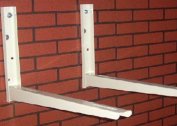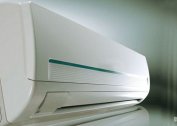After buying climate equipment, an important point is the installation of a split system. The quality of the work will depend on how long and trouble-free the device will be in operation. Therefore, the installation steps are immediately specified - the installation of the indoor unit, the nuances of installing an external unit, evacuation of the air conditioning system.
Connecting, evacuating and replacing the radiatordo-it-yourself air conditioner - These are quite complex procedures that require special skills and knowledge.
Air conditioner connection
 Beforeconnecting the air conditioner prepare the necessary tool, hang the outdoor and indoor units. Sequencing:
Beforeconnecting the air conditioner prepare the necessary tool, hang the outdoor and indoor units. Sequencing:
- To lay the piping and electric cables in the wall between the blocks, drill holes with a diameter of about 6 centimeters.
- As pipelines, copper pipes are used, the characteristics of which are indicated in the manual. The pipes are cut with a special tool that excludes the appearance of metal chips, they are expanded and bent using a pipe bender.
- The pipe is connected to the mounting location previously treated with sealant.
- Produce evacuation.
- Open the service valve.
- Connect the electrical wires.
- Mount the drain hose.
- All pipelines and the drainage tube are rewound with insulation tape.
When evacuation is necessary
During installation, both units are interconnected by copper pipes for circulation of the refrigerant. This is the air conditioner circuit. After laying the copper pipe, all pipes are tightly connected and tightened to prevent atmospheric air from entering inside. Even with great effort to remove air from the pipes by blowing, it will not be possible to completely get rid of it.
Evacuation of the air conditioner is a mandatory procedure both for household appliances where the line length does not exceed 2 meters, and for office or industrial installations where the length of freon pipes can reach tens of meters.
What is it for:
- air vapors dissolve in oil, which is responsible for lubricating compressor parts, this leads to a change in the characteristics of the lubricant and it performs its functions worse: it does not form a dense film on the surface of rubbing parts; the mechanism wears out faster and the risk of compressor jamming increases;
- moisture changes the chemical characteristics of the coolant, which threatens to reduce the performance of the air conditioner, signs of freezing will be visible on the circuit.
Evacuation is carried out before the first start-up, in order to prevent contact of the oil with residual air or water.
Vacuum and refueling equipment
 For work, the following tools and devices are needed:
For work, the following tools and devices are needed:
- Vacuum station for air conditioners. Before filling the refrigerant, it is connected to the circuit and drains it. Pressure gauges on the device indicate the level of vacuum. In the work of the master, two-stage models are used, which are economical in terms of energy consumption, easy to install. Heterionic vacuum cleaners provide good cleaning for air conditioners, but are rarely used because they are expensive.
- Manometric manifold.
- A set of screwdrivers and wrenches for working with fittings.
- Cylinder with freon for subsequent refueling.
The most important device is the pump, which will seal the pipeline. Convenience in work creates the weight of the device - the lighter it is, the easier. Models that have a rubber mount to reduce vibration levels are more convenient to use.
During operation, the pump consumes oil, therefore, an indication of its level is a useful function for a person who constantly works with the device.
To remove vapors, a valve must be provided, as well as a set of fittings designed for the outdoor unit through which air evacuation takes place.
The market is dominated by German, American, and Swiss manufacturers of equipment for HVAC equipment at various price levels. Some Chinese firms supply products that are not inferior in quality to European counterparts, but much cheaper.
Professional repairmen use large cylinders with refrigerant, as they often carry out installation, refueling and refueling pipelines of customers of the service. For a single use, it is enough to buy a small amount of freon, so as not to overpay.
Split system preparation
 Before starting the operation of the vacuum pump, it is connected via a manometric station to the tap of the outdoor unit of the air conditioner. Gauge station is needed to control the vacuum level, after which the device is turned off. Some time after the end of the evacuation process, the master observes the performance of the instruments. If they do not change, work is carried out to fill the circuit with refrigerant - the system is tight, unnecessary vapors are removed. If the pressure gauge readings change, the line is checked for cracks - freon will leak from the pipes, which will require repair shortly after installation.
Before starting the operation of the vacuum pump, it is connected via a manometric station to the tap of the outdoor unit of the air conditioner. Gauge station is needed to control the vacuum level, after which the device is turned off. Some time after the end of the evacuation process, the master observes the performance of the instruments. If they do not change, work is carried out to fill the circuit with refrigerant - the system is tight, unnecessary vapors are removed. If the pressure gauge readings change, the line is checked for cracks - freon will leak from the pipes, which will require repair shortly after installation.
Before filling the circuit with coolant, the pump is disconnected. With the help of a hex wrench, freon taps are opened, the liquid enters the air conditioner circuit, making a hissing sound. How much refrigerant must be charged and what type is described in the manufacturer's instructions.
After filling the pipes with refrigerant, the pressure gauge is observed for half an hour. During this time, the pressure indicators should not change. Otherwise, they look for leaks and vacuum again and fill the line. Leaks occur due to weak or very strong clamping of nuts on the fittings, poor soldering or flaring of copper pipes. Collisions on pipes can also cause freon leakage, since excessive metal tension forms cracks.
How long does the evacuation process take?
 The process of evacuating the air conditioner lasts from 10 to 20 minutes. It depends on the power of the split system, the thickness of the pipes. For industrial or office systems, vacuuming and filling with freon lasts longer, since the length of the pipeline reaches several tens, and sometimes hundreds of meters. At such facilities, monitoring the depth of vacuum after sealing lasts about an hour. Sometimes you need to restart the device.
The process of evacuating the air conditioner lasts from 10 to 20 minutes. It depends on the power of the split system, the thickness of the pipes. For industrial or office systems, vacuuming and filling with freon lasts longer, since the length of the pipeline reaches several tens, and sometimes hundreds of meters. At such facilities, monitoring the depth of vacuum after sealing lasts about an hour. Sometimes you need to restart the device.
When the indicators in the pipeline cease to change in a certain period of time, you can proceed to filling them with freon.
Do-it-yourself air conditioning evacuation
To vacuum the air conditioner yourself, you need to stock up on low and high pressure hoses.
The end of the hose without a protrusion is connected to the pump. The opposite end, equipped with a pin, is attached to the gas port spool, after which the pump starts for 10 minutes. At the end of the evacuation, it is necessary to open the valve to start the freon and immediately close it by disconnecting the hose. A small amount of refrigerant will be lost, but this is normal, loss is possible when replacing the air conditioner radiator.
During purging of routes with a length of more than 6 meters, the vacuum method is used to preserve freon, which otherwise would be released, and refueling is not possible.
After pumping out air and moisture from the pipeline, unscrew the liquid and gas valves until they stop (all seven revolutions). Compounds are treated with soap suds to detect possible leaks.


